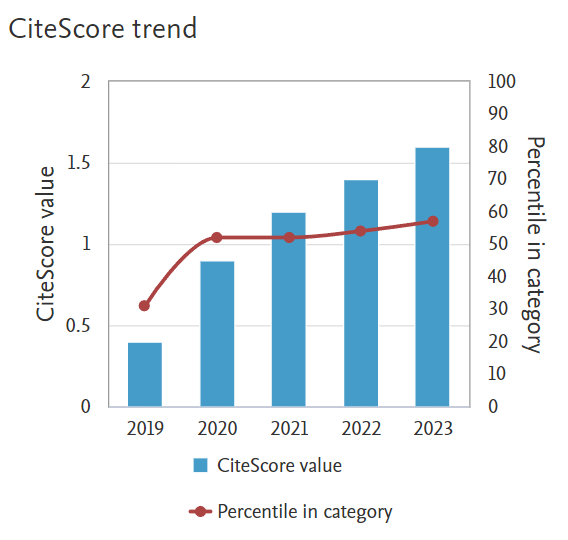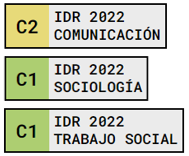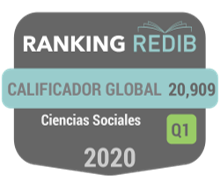Open wall churches. Catholic construction of online communities
Palabras clave:
religion, digital religion, Catholicism, on-line community, technology, participationResumen
The discussion regarding how global Catholic organizations have employed the new tools of digital media has become increasingly poignant and no longer focuses on liturgical limitations but on participation, social justice and new frameworks for reaching new targets. From the Vatican itself, specifically through the Pope’s profiles on social media, Catholicism has proven to have an increasingly responsive presence on the web, although Catholics are usually creative without breaking the rules in the ways they extend their religiosity into new platforms. Newly born digital portals have embraced new participatory tools that shape other ways of understanding communion, which is a key concept among Christian communities. Rather than dwelling on whether Catholic portals are incorporating secular strategies to foster engagement, we explore the 19 most powerful Catholic websites according to Alexa ranking, and divide them into different categories that allow us to analyse how they build communities and thus foster the concept of belonging, which is one of the aims that they pursue. Data have been collected in three different moments (2014, 2015 and 2016) where these websites, belonging to 5 languages (Spanish, English, French, Portuguese and Italian) from 9 countries have been taken into account, according to Catholic population indexes.
Descargas
Citas
Arasa, D. (2008). Church Communications Through Diocesan Websites. A Model of Analysis. Rome, Italy: Edusc.
Arthur, C. (1993). Religion and the Media. Cardiff, United Kingdom: University of Wales Press.
Babin, P. and Iannone, M. (1991). The New Era in Religious Communication. Minneapolis, United States: Augsburg Fortress.
Baym, N. (1995). The Emergence of Community in Computer-Mediated Communication. In S.G. Jones. (Ed.), Cybersociety. Computer-mediated communication and community (pp.138-163). London, United Kingdom: Sage Publications.
Brasher, B. (2001). Give Me that Online Religion. San Francisco, United States: Jossey-Bass.
Burbules, N. (2002). The web as a rhetorical place. Silicon Literacies. Communication, Innovation and Education in the Electronic Age 1, pp. 75-85. London, United Kindom: Routledge. doi: http://dx.doi.org/10.1007/978-0-387-30424-3_262
Calvarese, M. (2016). La preghiera corre anche sul whatsapp. Agensir. Retrieved from http://agensir.it/italia/2016/07/02/la-preghiera-corre-anche-su-whatsapp/
Campbell, H. (2005). Exploring religious community online. We are on the network. New York, United States: Peter Lang Publishing.
Campbell, H. (2012). Understanding the Relationship between Religion Online and Offline in a Networked Society. Journal Of The American Academy Of Religion, 80(1), 64-93. http://dx.doi.org/10.1093/jaarel/lfr074
Cantwell, C. D., and Hussein, R. (2015). Religion, Media and the Digital Turn. A Report for the Religion and the Public Sphere Program Social Science Research Council. Brooklyn, United States: SSRC.
Carbonell, J.M., Díez, M., and Micó, J.L. (2013). Technology versus Religion. The Religious Tech-Adaptation. In Proceedings of International Conference on the Modern Development of Humanities and Social Science (pp. 257-260). Hong-Kong, China: Atlantis.
Celli, C. M. (2013). La comunicación de la fe en el horizonte de la nueva evangelización. Catholic.net. Retrieved from http://goo.gl/QECGYV
Conrad, C., and Poole, M. S. (2005). Strategic Organizational Communication in a Global Economy. Belmont, United States: Thomson- Wadsworth.
Dawson L.L., and Cowan, D.E. (2004). Religion Online: Finding Faith in the Internet. Abingdon, United Kingdom: Routledge.
Díez, M., Micó, J.L., and Carbonell, J. M. (2015). Negotiating religious visibility in digital media. Barcelona, Spain: Blanquerna Observatory on Media, Religion and Culture.
Díez, M., Micó, J.L., and Carbonell, J. M. (2015). Catholic Communities Online. Barcelona, Spain: Blanquerna Observatory on Media, Religion and Culture.
Dodge, M., and Kitchin, R. (2001). Mapping Cyberspace, Abingdon, United Kingdom: Routledge.
Gascue Quiñones, A. (2010). Facebook: McLuhan’s global village?. In M. Ciastellardi, M., Miranda, C., AND Scolari, C. A. Proceedings of McLuhan Galaxy Conference. Understanding Media Today (p.116). Barcelona, Spain: Editorial UOC.
Gupta, S., and Kim, H. (2004). Virtual Community: Concepts, Implications, and Future Research Directions. In Proceedings of the Tenth Americas Conference on Information Systems (pp.2679-2687). New York, United States: AMCIS.
Helland, C. (2005). Online Religion as Lived Religion. Methodological Issues in the Study of Religious Participation on the Internet. Online-Heidelberg Journal for Religions on the Internet, 1(1).
Hjarvard. S. (2008). The mediatisation of religion: Theorising religion, media and social change. Culture and Religion, 12(2), 119-35. doi: http://dx.doi.org/10.1080/14755610.2011.579719
Højsgaard, M. T., and Warburg, M. (2005). Religion and Cyberspace. Abingdon, United Kingdom: Routledge.
Holtzman, S. R. (1994). Digital Mantras. The Languages of Abstract and Virtual Worlds. Cambridge, United States: The MIT Press.
Horsfield, P. (2015). From Jesus to Internet. A History of Christianity and Media. Chichester, United Kingdom: Wiley Blackwell.
Hoover, S. M., and Kaneva, N. (2009). Fundamentalisms and the Media. New York, United States: Continuum.
Hutchings, T. (2015). The Smartest Way to Study the Word. Protestant and Catholic Approaches to the Digital Bible. In Díez, M., Micó, J.L., and Carbonell, J. M. (eds.), Negotiating Religious Visibility in Digital Media (pp.209-224). Barcelona, Spain: Blanquerna Observatory on Media, Religion and Culture.
Hutchings, T. (2015). Christianity and Digital Media. In Brunn, S.D. (ed.), The Changing World Religion Map (p. 3827). Dorchrecht, The Netherlands: Springler.
Kitchin, R. (1998). Cyberspace. The world in the wires. Chichester, United kingdom: John Wiley & Sons.
Karaflogka, A. (2006). E-religion. A Critical Appraisal of Religious Discourse on the World Wide Web. London, United Kingdom: Equinox.
Kollock, P., and Smith, M. A. (1999). Communities in cyberspace. London, United Kingdom: Routledge.
Lajoie, M. (1996). Psychoanalysis and Cyberspace. In Shields, R. (ed.), Cultures of Internet. Virtual spaces, real histories, living bodies (pp.160-161). London, United Kingdom: Sage Publications.
Long, J. (1997). Generating Hope. Reaching the Postmodern Generation. London, United Kingdom: Marshall Pickering.
McTeigue, R. (2014). Online Catholic Community? Let’s Get Real. Aleteia. Retrieved from http://aleteia.org/2014/10/09/online-catholic-community-lets-get-real/
Morgan, M. L. (1994). Religion, history and moral discourse. In Tully, J. (ed.), Philosophy in an Age of Pluralism. The philosophy of Charles Taylor in question (pp. 49-66). Cambridge, United Kingdom: Cambridge University Press. doi: https://doi.org/10.1017/CBO9780511621970.006
Pontifical Council for Social Communications. (1971). Communio et Progressio. Rome, Italy: Libreria Editrice Vaticana.
Rheingold, H. (1993). The Virtual Community: Home-Steading on the Electronic Frontier. Reading, United States: Addison-Wesley.
Reising, R. L. (2006). Church Marketing 101: Preparing Your Church for Greater Growth. Grand Rapids, United States: Baker Books.
Sorice, M. (2012). Social media e Chiesa. Il tempo del dialogo. In Sanna, I. (ed.), L’etica della comunicazione nell’era digitale (pp. 123-141). Rome, Italy: Studium.
Soukup, P. (2015). Biblical aspects of the new digital culture. In Díez, M., Micó, J.L., and Carbonell, J. M. (eds.), Catholic communities online (p. 12). Barcelona, Spain: Blanquerna Observatory on Media Religion and Culture.
Spadaro, A. (2014). Cybertheology: Thinking Christianity in the Era of the Internet. New York, United States: Fordham University Press.
Tridente, G., and Mastroianni, B. (2016). La missione digitale. Comunicazione della Chiesa e Social Media. Rome, Italy: Edusc.
Turkle, S. (1995). Life on the Screen. Identity in the Age of the Internet. New York, United States: Simon & Schuster.
Valovic, T. (2002). Digital Mythologies. The hidden complexities of the Internet. London, United Kingdom: Rutgers University Press.
Wagner, R. (2012). Godwired: Religion, Ritual and Virtual Reality. Abingdon, United Kingdom: Routledge.
Wilbur, S. P. (1996). An Archaeology of Cyberspaces: Virtuality, Community, Identity. In Porter, D. (ed.), Internet Culture (pp. 45-44). Abingdon, United Kingdom: Routledge.
Vitullo, A. (2013). Religione e web: simpatia per il diavolo?. Reset. Retrieved from http://www.reset.it/caffe-europa/religione-e-web-simpatia-per-il-diavolo
Wooden, C. (2011). Catholic bloggers meet at the Vatican. National Catholic Reporter. Retrieved from https://www.ncronline.org/news/vatican/catholic-bloggers-meet-vatican
Zaleski, J. P. (1997). The soul of cyberspace: How new technology is changing our espiritual lives. San Francisco, United States: HarperCollins.
Descargas
Publicado
Cómo citar
Número
Sección
Licencia
Los autores/as que publiquen en esta revista aceptan las siguientes condiciones:
- Los autores/as conservan los derechos de autor.
- Los autores/as ceden a la revista el derecho de la primera publicación. La revista también posee los derechos de edición.
- Todos los contenidos publicados se regulan mediante una Licencia Atribución/Reconocimiento-SinDerivados 4.0 Internacional. Acceda a la versión informativa y texto legal de la licencia. En virtud de ello, se permite a terceros utilizar lo publicado siempre que mencionen la autoría del trabajo y a la primera publicación en esta revista. Si transforma el material, no podrá distribuir el trabajo modificado.
- Los autores/as pueden realizar otros acuerdos contractuales independientes y adicionales para la distribución no exclusiva de la versión del artículo publicado en esta revista (p. ej., incluirlo en un repositorio institucional o publicarlo en un libro) siempre que indiquen claramente que el trabajo se publicó por primera vez en esta revista.
- Se permite y recomienda a los autores/as a publicar su trabajo en Internet (por ejemplo en páginas institucionales o personales), una vez publicado en la revista y citando a la misma ya que puede conducir a intercambios productivos y a una mayor y más rápida difusión del trabajo publicado (vea The Effect of Open Access).

















